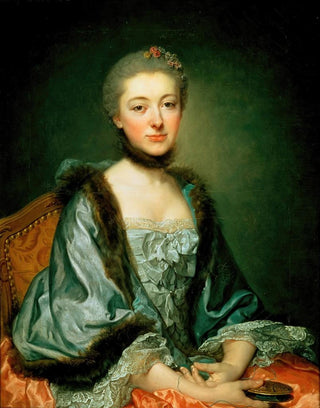Art print | Portrait of Marie Angélique Vrany de Varennes Mme Georges Gougenot de Croissy - Jean-Baptiste Greuze


View from behind

Frame (optional)
The "Portrait of Marie Angélique Vrany de Varennes Mme Georges Gougenot de Croissy" is an iconic work from the 18th century, signed by the French master Jean-Baptiste Greuze. This painting, which captures the very essence of the sensitivity and elegance of its era, immerses us in a universe where beauty and grace are elevated by the artist's exceptional talent. Through this portrait, Greuze does not merely depict a female figure; he invites the viewer to discover a world of delicacy and refinement, where every detail is carefully crafted to evoke a deep emotion.
Style and uniqueness of the work
Greuze's style is distinguished by its intimate and realistic approach, which is evident in the portrayal of Marie Angélique Vrany de Varennes. The artist employs a palette of soft, harmonious colors, creating a subtle contrast between the glow of the skin and the richness of the surrounding fabrics. Light and shadow play a crucial role in the composition, highlighting the delicate features of his model while adding depth to the overall piece. The woman's posture, slightly turned towards the viewer, along with her penetrating gaze, establishes a silent dialogue that invites contemplation. Greuze manages to capture not only the physical appearance of his subject but also her character and soul, making this work unique in the artistic landscape of his time.
The artist and his influence
Jean-Baptiste Greuze, born in 1725, is a major figure in 18th-century French painting. A student of the Royal Academy of Painting, he quickly distinguished himself by his talent and his ability to blend realism with emotional sensitivity. Greuze is often regarded as a precursor to Romanticism, as he deeply explores the psychology of his characters. His portraits, such as that of Marie Angélique, reflect his desire to represent the individual in all their complexity. Greuze's influence extends beyond his era, inspiring many artists who followed, particularly in the fields of portraiture and genre painting. His capacity

Matte finish

View from behind

Frame (optional)
The "Portrait of Marie Angélique Vrany de Varennes Mme Georges Gougenot de Croissy" is an iconic work from the 18th century, signed by the French master Jean-Baptiste Greuze. This painting, which captures the very essence of the sensitivity and elegance of its era, immerses us in a universe where beauty and grace are elevated by the artist's exceptional talent. Through this portrait, Greuze does not merely depict a female figure; he invites the viewer to discover a world of delicacy and refinement, where every detail is carefully crafted to evoke a deep emotion.
Style and uniqueness of the work
Greuze's style is distinguished by its intimate and realistic approach, which is evident in the portrayal of Marie Angélique Vrany de Varennes. The artist employs a palette of soft, harmonious colors, creating a subtle contrast between the glow of the skin and the richness of the surrounding fabrics. Light and shadow play a crucial role in the composition, highlighting the delicate features of his model while adding depth to the overall piece. The woman's posture, slightly turned towards the viewer, along with her penetrating gaze, establishes a silent dialogue that invites contemplation. Greuze manages to capture not only the physical appearance of his subject but also her character and soul, making this work unique in the artistic landscape of his time.
The artist and his influence
Jean-Baptiste Greuze, born in 1725, is a major figure in 18th-century French painting. A student of the Royal Academy of Painting, he quickly distinguished himself by his talent and his ability to blend realism with emotional sensitivity. Greuze is often regarded as a precursor to Romanticism, as he deeply explores the psychology of his characters. His portraits, such as that of Marie Angélique, reflect his desire to represent the individual in all their complexity. Greuze's influence extends beyond his era, inspiring many artists who followed, particularly in the fields of portraiture and genre painting. His capacity






